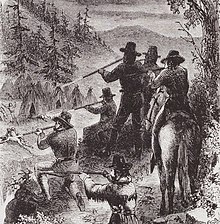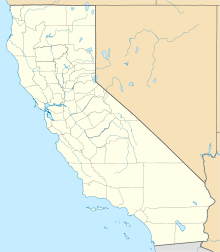| Mariposa War | |||||||
|---|---|---|---|---|---|---|---|
| Part of California Genocide | |||||||
 Members of the Mariposa Battalion firing into an indigenous people encampment during a campaign in the Mariposa War | |||||||
| |||||||
| Combatants | |||||||
| Mariposa Battalion |
Ahwahnechee Chowchilla | ||||||
| Commanders and leaders | |||||||
| James D. Savage |
Tenaya Jose Juarez Jose Rey | ||||||
| Units involved | |||||||
|
Company A Company B Company C | Native Americans | ||||||
| Strength | |||||||
| ~200 militia | Unknown | ||||||
| Casualties and losses | |||||||
| Several killed and wounded | Unknown | ||||||
Location within California | |||||||
The Mariposa War (December 1850 – June 1851), also known as the Yosemite Indian War, was a conflict between the United States and the indigenous people of California's Sierra Nevada in the 1850s. The war was fought primarily in Mariposa County and surrounding areas, and was sparked by the discovery of gold in the region. As a result of the military expedition, the Mariposa Battalion became the first non-indigenous group to enter Yosemite Valley and the Nelder Grove.[1]
The war began in 1850 when miners entered the area of the Sierra Nevada foothills, which was traditionally occupied by the Ahwahnechee, a band of the Southern Sierra Miwok people. The miners began to take over the Ahwahnechee's land and resources, leading to tensions between the two groups.
The Ahwahnechee, led by their chief Tenaya, fought back against the miners resulting in a series of skirmishes that escalated into a full-scale war. The California state government, under Governor John McDougall, raised the Mariposa Battalion led by Sheriff James D. Savage to subdue the indigenous people.[2][3]
The war ended in 1851 with the capture of Tenaya and the surrender of his band. The Ahwahnechee were subsequently removed from the Sierra Nevada foothills and forced to live on reservations. The war resulted in the deaths of an unknown number of Ahwahnechee and several miners, and the displacement of the indigenous people from their ancestral lands.[4]
The Mariposa War was a part of the broader historical context of the California genocide and the American Indian Wars. Many European American settlers considered Native Americans to be an "Indian Problem" which they needed to remove.[4] The United States government, California state government, and White settlers enforced deliberate policies of displacement, forced removals, and massacres that drove Native Americans from their traditional lands and onto reservations.
- ^ Eccleston, Robert (1957). C. Gregory Crampton (ed.). The Mariposa War, 1850–1851. University of Utah Press.
- ^ Beck, Warren A.; Hasse, Ynez D. "Mariposa Indian War". California State Military Museum. Retrieved January 14, 2023.
- ^ "People". Yosemite National Park. National Park Service. January 14, 2023. Retrieved January 14, 2023.
The first non-native group to enter Yosemite was the Mariposa Battalion, a Euro-American militia formed to drive the native Ahwahneechee people onto reservations.
- ^ a b "California's Little-Known Genocide". HISTORY. 2023-07-11.

